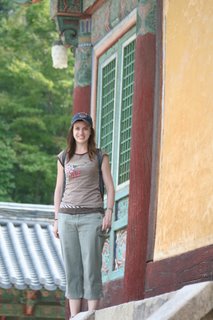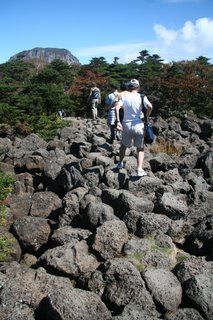For the Chuseok long weekend we stepped back to 57 BC and explored Gyeongju, the ancient capital of the Silla Dynasty. Despite the fact that most of the Silla relics were destroyed during the Japanese occupation (and purposeful cultural destruction) of Korea, some areas of Gyeongju definitely evoke a sense of Korea's rich history.
One of the highlights of exploring old Gyeongju was Bulguksa, a world heritage listed Silla temple terraced on a mountainside. A couple of stone pagodas that escaped Japanese destruction still stand as originally constructed over 1400 years ago.

An imposing shamanist deity guards the entrance to Bulguksa

Bulguksa

Seokgatap- one of the stone pagodas that exist in their original state

Me at Bulguksa
Another of the impressive sites of Gyeongju are the sea of Tumuli, the grass covered burial mounds of Silla royalty, that rise above the low-rise buildings of Gyeongju residents. These enormous mounds, serving a similar purpose to the Egyptian pyramids, are tombs in which Silla kings and queens are buried with their earthly possessions.

Trent and Denise in the main Tumuli park in Gyeongju

Denise dwarfed by a tumulus
As we discovered, there is another side to Gyeongju- the new resort area around Bomun Lake, where our hotel was located. Some of the lakeside development is in keeping with the historic feel of Gyeongju and other elements are not- most notably the 100's of motorised four-wheelers and motorbikes that are hired out by anyone between the age of about 5 and 60! We couldn't resist the temptation to join the local hoons and Trent and I hired a four-wheeler and beat the odds to emerge unscathed from the heavily-trafficked bike paths.

A beautiful pond and pagoda in a park near our hotel

Bomun lakeside

Light and sound show at one of the luxury hotels

Trent and Denise on our afternoon ride around the lake

Reflection of a pagoda in a lily pond

The crazy riders of Gyeongju- a definite hazard to pedestrians!
The fantastically efficient train system of South Korea enabled us to leave Gyeongju on the same day that we had to return to work after the Chuseok break. For most of the trip we took a speedy (up to 300kms/hr) ride on the KTX. Smoother and more comfortable than most planes I've taken.

Denise and me on the KTX
























